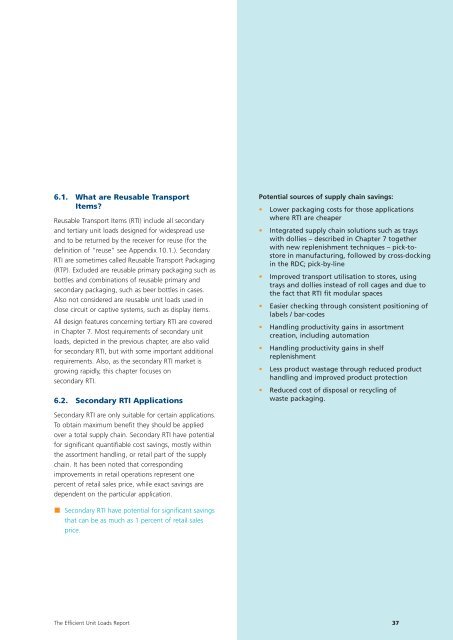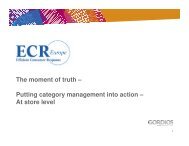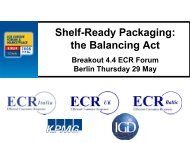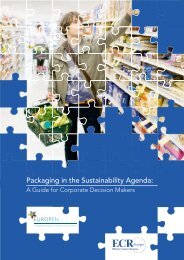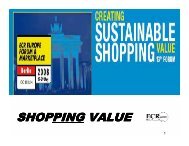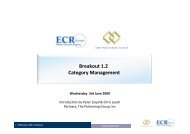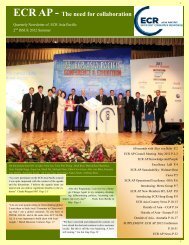You also want an ePaper? Increase the reach of your titles
YUMPU automatically turns print PDFs into web optimized ePapers that Google loves.
6.1. What are Reusable Transport<br />
Items?<br />
Reusable Transport Items (RTI) include all secondary<br />
and tertiary unit loads designed for widespread use<br />
and to be returned by the receiver for reuse (for the<br />
definition of “reuse” see Appendix 10.1.). Secondary<br />
RTI are sometimes called Reusable Transport Packaging<br />
(RTP). Excluded are reusable primary packaging such as<br />
bottles and combinations of reusable primary and<br />
secondary packaging, such as beer bottles in cases.<br />
Also not considered are reusable unit loads used in<br />
close circuit or captive systems, such as display items.<br />
All design features concerning tertiary RTI are covered<br />
in Chapter 7. Most requirements of secondary unit<br />
loads, depicted in the previous chapter, are also valid<br />
for secondary RTI, but with some important additional<br />
requirements. Also, as the secondary RTI market is<br />
growing rapidly, this chapter focuses on<br />
secondary RTI.<br />
6.2. Secondary RTI Applications<br />
Secondary RTI are only suitable for certain applications.<br />
To obtain maximum benefit they should be applied<br />
over a total supply chain. Secondary RTI have potential<br />
for significant quantifiable cost savings, mostly within<br />
the assortment handling, or retail part of the supply<br />
chain. It has been noted that corresponding<br />
improvements in retail operations represent one<br />
percent of retail sales price, while exact savings are<br />
dependent on the particular application.<br />
Secondary RTI have potential for significant savings<br />
that can be as much as 1 percent of retail sales<br />
price.<br />
Potential sources of supply chain savings:<br />
• Lower packaging costs for those applications<br />
where RTI are cheaper<br />
• Integrated supply chain solutions such as trays<br />
with dollies – described in Chapter 7 together<br />
with new replenishment techniques – pick-tostore<br />
in manufacturing, followed by cross-docking<br />
in the RDC; pick-by-line<br />
• Improved transport utilisation to stores, using<br />
trays and dollies instead of roll cages and due to<br />
the fact that RTI fit modular spaces<br />
• Easier checking through consistent positioning of<br />
labels / bar-codes<br />
• Handling productivity gains in assortment<br />
creation, including automation<br />
• Handling productivity gains in shelf<br />
replenishment<br />
• Less product wastage through reduced product<br />
handling and improved product protection<br />
• Reduced cost of disposal or recycling of<br />
waste packaging.<br />
The Efficient Unit Loads Report 37


